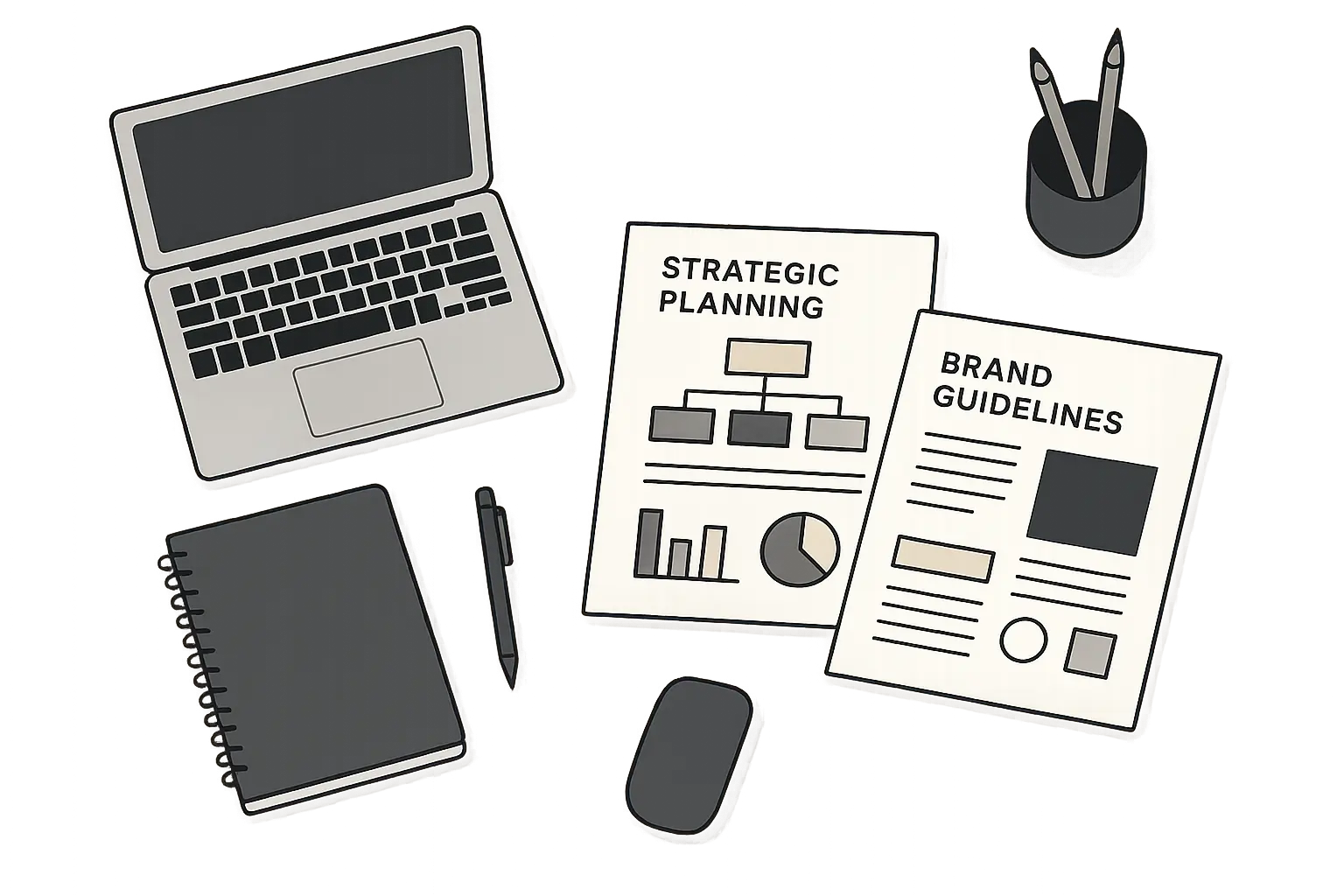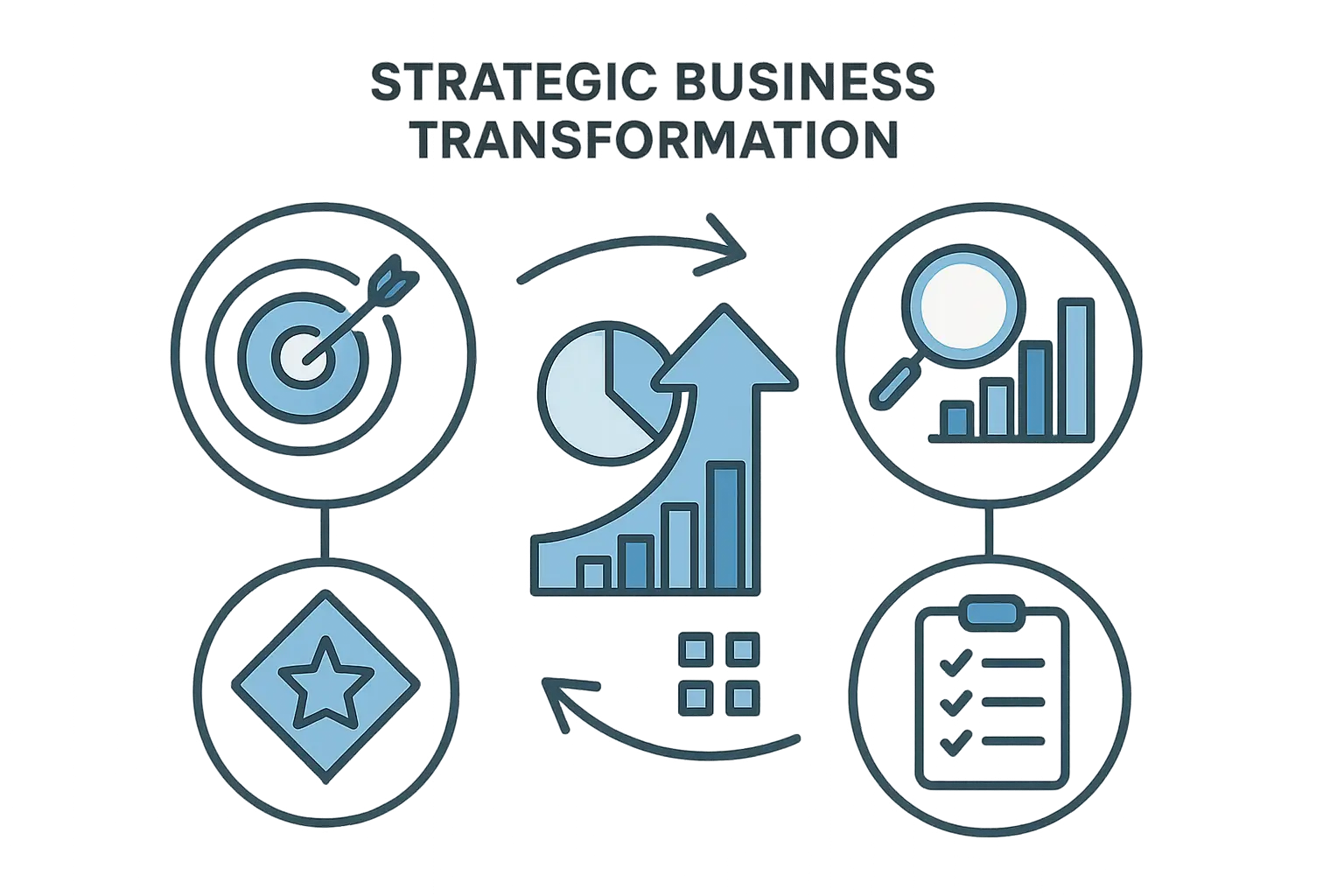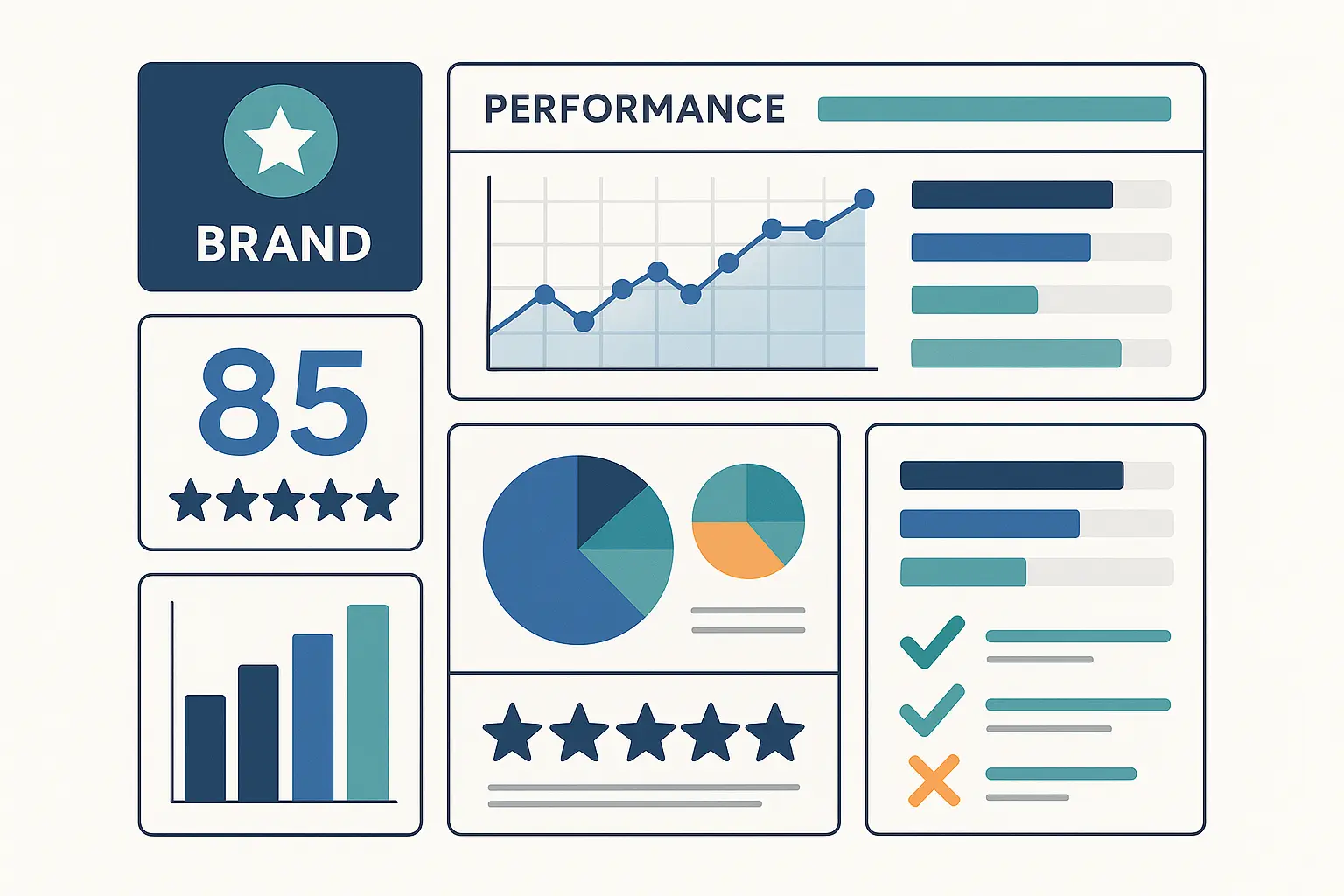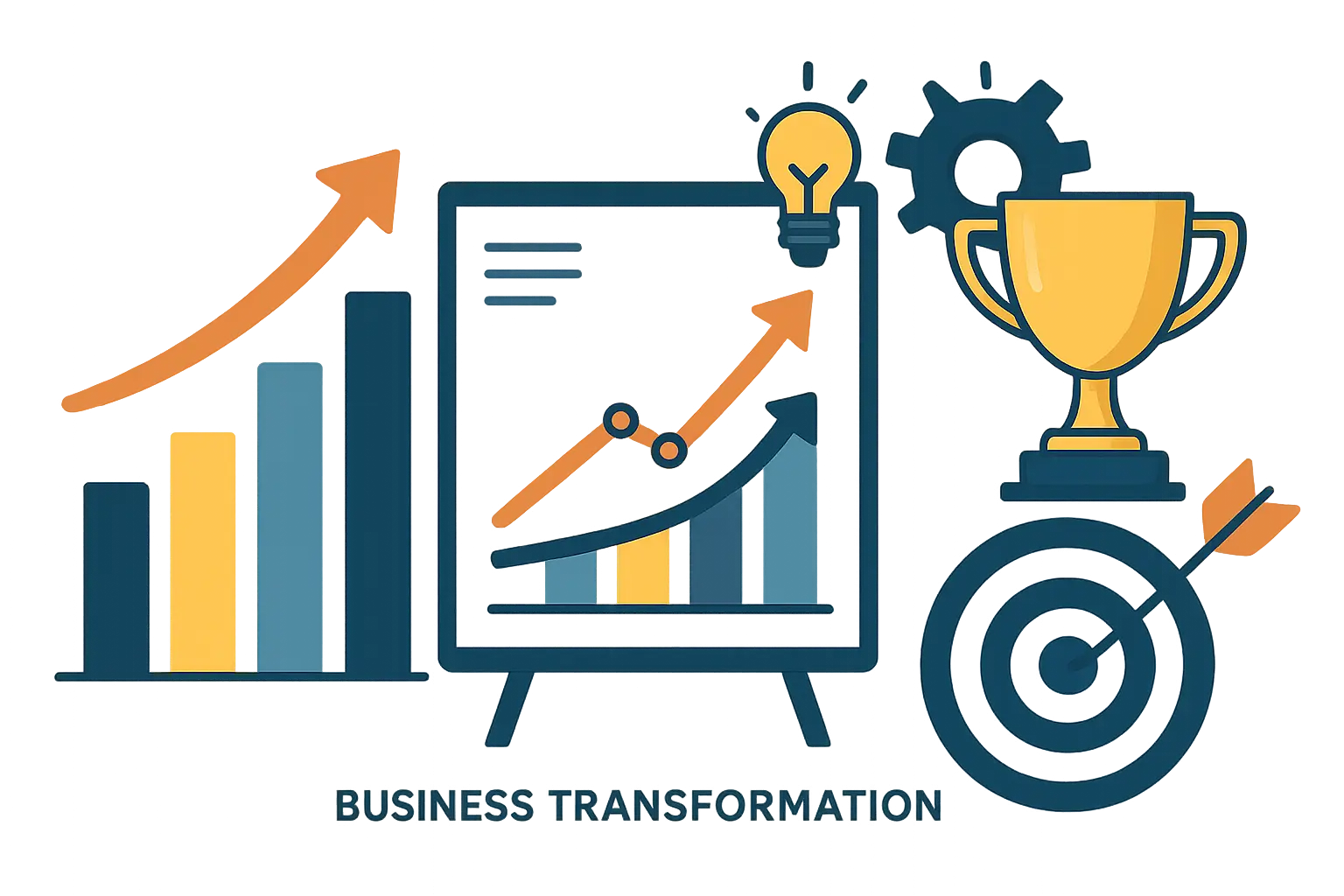Look, I’ll be straight with you—most B2B branding case studies are pretty useless. They show you a shiny new logo and call it a day. But after digging through hundreds of rebrands over the last few years, I found 25 that actually moved the needle on revenue, not just vanity metrics.
According to recent research by Column Five Media, companies that implement strategic B2B branding initiatives see an average of 183% increase in site traffic and significant improvements in market visibility. But here’s what they don’t tell you: most of these transformations took 2-3 years to show real results, not the overnight success stories everyone wants to believe.
I’ve been in B2B marketing for over 8 years, and I’ve watched $50M companies blow 18 months on rebrands that nobody—and I mean nobody—understood. Their sales teams were still using old pitch decks six months after launch. That’s not what we’re talking about here.
These 25 examples are different. They’re comprehensive brand transformations that fundamentally changed how these companies compete and win in their markets. Not just prettier design updates, but strategic repositioning that created real competitive advantages.
Source: Column Five Media B2B Marketing Case Studies

Table of Contents
-
What Makes a B2B Branding Case Study Worth Studying
-
Technology & Software Transformations (5 Case Studies)
-
Professional Services & Consulting Evolution (5 Case Studies)
-
Manufacturing & Industrial Innovation (4 Case Studies)
-
Financial Services & Fintech Revolution (4 Case Studies)
-
Healthcare & Pharmaceuticals Advancement (4 Case Studies)
-
Energy & Sustainability Leadership (3 Case Studies)
-
Deep Dive Analysis: The Game-Changers
-
How to Evaluate B2B Branding Success
-
Why Most B2B Rebrands Fail (And How to Avoid It)
TL;DR
-
Good B2B branding isn’t rocket science—you need clear goals, know who you’re talking to, and measure if it’s working. Skip the fancy jargon.
-
The winners create new market categories (like HubSpot’s “inbound marketing”) instead of fighting over scraps in existing ones
-
Your rebrand needs to work everywhere—trade shows, LinkedIn, sales decks, customer support. Inconsistency kills credibility fast
-
Tech companies are crushing it because Salesforce, Microsoft, and HubSpot figured out how to own entire categories, not just compete on features
-
Don’t expect overnight magic—brands like Zoom and Slack spent years building trust before becoming household names
-
Every decision needs data backing it—gut feelings and creative hunches are expensive ways to fail
-
Get your own team on board first—external success is impossible when your sales team doesn’t understand the new positioning
What Makes a B2B Branding Case Study Worth Studying
When I evaluate B2B branding case studies, I look for three things that separate the winners from the pretenders. First, does this solve a real business problem with clear objectives? Second, can they actually deliver the brand experience consistently everywhere it matters? Third, did it move business metrics that executives care about—revenue, market share, competitive wins?
Most case studies fail this test miserably. They’ll show you before-and-after logos and throw around words like “brand perception improvement.” That’s not strategy—that’s decoration.
Here’s what I’ve learned after watching hundreds of these transformations: the ones that work start with brutal honesty about business problems, not creative inspiration.
|
What Actually Matters |
The BS to Ignore |
Red Flags That Scream “Run” |
|---|---|---|
|
Clear business objectives, defined buyer personas, real competitive advantages |
Vague goals like “improve brand perception,” generic messaging that could apply to anyone |
When they say stuff like “synergistic brand optimization” or can’t explain the strategy to a 12-year-old |
|
Consistent experience across every touchpoint, scalable systems, genuine innovation |
Rigid brand police mentality, cookie-cutter approaches, playing it safe |
Different messages on your website vs. sales deck vs. trade show booth |
|
Revenue growth, market share gains, shorter sales cycles, better win rates |
Vanity metrics like “brand awareness lift,” short-term publicity buzz |
Only measuring likes, shares, and other feel-good numbers that don’t pay bills |
Strategic Foundation: What Actually Matters
Your rebrand needs to start with crystal-clear business objectives that connect directly to revenue. I’m talking about specific, measurable goals—not fluffy aspirations about “improving brand perception.” The best rebrands I’ve studied solve real competitive problems or capitalize on genuine market opportunities.
Here’s the thing about B2B target audiences: they’re way more complex than B2C. You’re not just reaching one decision-maker—you’re influencing procurement teams, technical evaluators, financial approvers, and end users. Each persona has different concerns, different priorities, and different ways of consuming information.
When developing comprehensive B2B strategies, understanding your market sizing and business opportunity becomes crucial for positioning decisions that will drive long-term growth.
Take Salesforce’s approach to audience expansion. They started focused on sales teams, then systematically expanded to marketing (Marketing Cloud), customer service (Service Cloud), and commerce (Commerce Cloud). Each expansion required distinct messaging for different buyer personas while maintaining core brand consistency. The sales VP cares about pipeline acceleration, the marketing director focuses on lead quality, and the service manager prioritizes customer satisfaction metrics. Same company, completely different conversations.
Competitive differentiation becomes your north star, but here’s what most companies get wrong: they try to differentiate on everything instead of owning one thing completely. What unique value can you deliver that competitors genuinely can’t match? This isn’t about being different for the sake of it—it’s about finding sustainable competitive advantages that translate into customer preference and pricing power.
Execution Excellence: Where Most Companies Screw Up
Multi-channel integration is where I see the most spectacular failures. I once worked with a company that spent $200K on a rebrand, then used Comic Sans in their trade show booth. Don’t be that company.
Your brand needs to work seamlessly across trade shows, LinkedIn campaigns, sales presentations, customer support interactions, and partner communications. Every touchpoint either reinforces your positioning or undermines it. There’s no neutral.
Scalability determines whether your rebrand can grow with your business or becomes a straightjacket. Can the brand strategy adapt across different markets, product lines, or business units? The most successful B2B brands I’ve analyzed build flexible frameworks rather than rigid rules that break under pressure.
Innovation factor matters because B2B buyers are increasingly sophisticated. They expect brands to demonstrate thought leadership and forward-thinking approaches. Playing it safe might feel comfortable, but it won’t help you stand out in crowded markets where everyone looks and sounds the same.

Technology & Software Transformations
Tech companies lead B2B branding innovation because they understand something most industries miss: you’re not selling products, you’re selling outcomes. The best transformations create entirely new categories instead of fighting over existing market share.
1. Salesforce: From CRM Tool to Customer Success Platform
Salesforce’s transformation represents the gold standard of B2B category expansion, and here’s why it worked: they didn’t just improve their CRM—they redefined what customer relationship management could become. The evolution from “No Software” to “Customer Success Platform” to “Customer 360” shows strategic thinking based on real market feedback, not boardroom brainstorming.
But here’s what most people don’t realize about their success: it took 15 years and hundreds of millions of dollars to get there. Their execution across Trailhead education, Dreamforce events, and industry-specific solutions didn’t happen overnight. They systematically built integrated brand experiences that create customer loyalty through genuine value delivery.
The results speak for themselves: revenue growth from $1.3B to $26.5B and market cap expansion from $8B to over $150B. That’s like a corner store becoming Walmart, but in the software world.
2. Microsoft: Cloud-First Digital Transformation
Microsoft’s pivot under Satya Nadella proves that even tech giants can successfully reinvent themselves, but only when they’re willing to cannibalize their existing business model. The “mobile-first, cloud-first” strategy wasn’t just internal reorganization—it was a complete brand repositioning from software vendor to digital transformation partner.
What impressed me most about their transformation was the emphasis on collaboration over competition. Instead of trying to kill Google and Amazon, they positioned themselves as the enterprise-friendly alternative. Their security focus and developer relations investment created new competitive moats that competitors still struggle to match.
The payoff was massive: $100B+ in annual cloud revenue, stock price increase from $37 to $400+, and completely transformed perception among developers and IT decision-makers who previously saw them as the “evil empire.”
3. HubSpot: Creating the Inbound Marketing Category
HubSpot didn’t just build better marketing software—they created an entirely new way of thinking about B2B marketing. By coining “inbound marketing” and building massive educational resources before selling software, they established thought leadership that competitors still can’t match.
Here’s what made their approach brilliant: they gave away their best strategies for free through content, tools, and certifications. This created a moat that goes far beyond product features. When prospects are ready to buy, who do you think they call—the company that educated them or the competitor who just sent sales emails?
This B2B marketing case study demonstrates how companies can leverage advanced analytics for strategic growth to build sustainable competitive advantages through data-driven positioning.
Their content-first approach, certification programs, and community building created sustainable differentiation. Revenue growth to $1.7B and over 135,000 customers proves that category creation beats feature competition every time.
4. Slack: Workplace Culture Revolution (And Its Limits)
Slack transformed internal communication from a necessary evil into a workplace culture enhancer. Their playful branding differentiated them from enterprise software stereotypes while their focus on team collaboration addressed real productivity challenges that email couldn’t solve.
But here’s the reality check: great branding can’t overcome fundamental competitive disadvantages. When Microsoft bundled Teams with Office 365, Slack’s superior user experience and brand affinity couldn’t compete with free distribution and enterprise sales relationships. The eventual acquisition by Salesforce shows that even beloved brands need sustainable competitive moats beyond just great messaging.
The lesson? Brand love is powerful, but distribution and pricing advantages can be more powerful.
5. Zoom: Reliability When It Matters Most
Zoom built their brand on one simple promise that everyone else overcomplicated: it just works. While competitors focused on feature lists and technical specifications, Zoom emphasized reliability during critical business moments. Simple message, flawless execution.
The 2020 remote work surge validated their positioning with 30x revenue growth, but here’s what impressed me more: their ability to maintain market share post-pandemic. When the world went back to offices, Zoom didn’t crater because they’d built genuine trust through consistent performance.
Becoming a verb synonymous with video conferencing represents the ultimate branding success. When your brand becomes the generic term for your category, you’ve won.

Professional Services & Consulting Evolution
Professional services firms face a unique branding challenge: how do you differentiate when you’re essentially selling smart people’s time? The winners figured out that thought leadership isn’t marketing—it’s the product itself.
6. Deloitte: Digital Age Consulting Leadership
Deloitte’s evolution from traditional accounting to digital transformation consulting shows how professional services can reinvent themselves for new market realities. But here’s what most people miss: they didn’t just change their messaging—they fundamentally changed their service delivery model.
Their emphasis on innovation and future-readiness attracts clients facing digital disruption challenges, but the real genius was integrating digital capabilities across all service lines under unified messaging. This helped them become the fastest-growing Big 4 firm with $59B in global revenue.
The key insight: professional services branding requires substance behind the positioning. You can’t fake expertise in markets where your reputation is everything.
7. McKinsey & Company: Research-Based Authority
McKinsey maintains premium positioning through the McKinsey Global Institute and consistent thought leadership publication, but here’s what makes their approach different: it’s not marketing disguised as research—it’s genuine intellectual property that even competitors reference.
They publish 40+ major research reports annually, covering everything from AI adoption to sustainability trends. Each report includes original survey data, proprietary frameworks, and actionable insights. This systematic approach to thought leadership demonstrates how intellectual capital becomes brand equity in professional services markets.
With $15B+ revenue and maintained prestige despite industry challenges, McKinsey demonstrates that research-first positioning justifies premium pricing when backed by genuine expertise and consistent execution.
8. PwC: Trust Through Transparency
PwC’s focus on trust and transparency helped rebuild their reputation after industry scandals, but the real story is how they operationalized these values throughout their service delivery. Their digital-first approach and regulatory compliance expertise positioned them as the reliable choice for risk-conscious enterprises.
$50B+ global revenue and maintained Big 4 status show that trust-based positioning works when backed by consistent execution and genuine transparency initiatives. But it took years of proving their commitment through actions, not just words.
9. Accenture: Strategy-to-Execution Bridge
Accenture positioned themselves as the bridge between strategy consulting and technology implementation, addressing a real gap in the market where clients wanted integrated solutions instead of multiple vendor relationships.
This practical innovation focus differentiates them from pure strategy firms like McKinsey and pure technology vendors like IBM. Their $61B revenue and position as the world’s largest consulting firm validates the strategy-plus-execution positioning in markets where clients are tired of consultants who can’t implement their recommendations.
10. IBM: AI and Hybrid Cloud Expertise (Mixed Results)
IBM’s transformation from hardware manufacturer to AI and cloud services leader shows both the potential and limitations of branding in rapidly evolving markets. Their Watson AI platform and Red Hat acquisition aimed to create hybrid cloud differentiation against hyperscale providers.
The mixed results ($23B cloud revenue but slower growth than competitors) prove an important point: even strong branding can’t overcome fundamental competitive disadvantages. When Amazon, Microsoft, and Google have better technology and lower prices, positioning alone won’t save you.
Sometimes the market just moves faster than your ability to transform, no matter how good your brand story sounds.

Manufacturing & Industrial Innovation
Manufacturing companies face a unique challenge: how do you make industrial equipment sexy? The winners figured out that sustainability, connectivity, and scientific innovation can transform commodity businesses into premium brands.
11. GE: Industrial Internet Pioneer (Lessons in Timing)
GE’s attempt to lead Industrial IoT through the Predix platform and “Industrial Internet” positioning showed both the potential and pitfalls of being too early to market. They invested heavily in software capabilities and digital talent acquisition, reaching $4B in digital revenue.
But here’s the reality check: the eventual scaling back of GE Digital demonstrates that market timing and execution matter as much as strategic vision. Sometimes being first to market means you pay for everyone else’s education while they learn from your mistakes.
The lesson? Even great positioning can’t overcome fundamental execution challenges or market timing issues.
|
Manufacturing Brand Success Stories |
Before |
After |
Reality Check |
|---|---|---|---|
|
GE |
Industrial conglomerate |
Industrial Internet leader |
$4B digital revenue, later scaled back due to execution challenges |
|
Caterpillar |
Heavy equipment manufacturer |
Sustainable construction leader |
$59B revenue maintained while building green credentials |
|
3M |
Diversified manufacturer |
Science applied to life |
$35B revenue across 60,000+ products proves science positioning works |
|
Honeywell |
Component manufacturer |
Connected building solutions |
$35B revenue with strong IoT platform growth |
12. Caterpillar: Sustainable Construction Focus
Caterpillar’s evolution toward sustainability messaging addresses growing environmental concerns in construction and mining without abandoning their core brand equity. The integration of green technology with traditional yellow branding maintains recognition while signaling innovation.
$59B revenue maintenance and improved sustainability credentials show that industrial companies can evolve their positioning without confusing existing customers or losing brand recognition built over decades.
13. 3M: Science Applied to Life
3M’s “Science Applied to Life” positioning leverages their materials science expertise across 60,000+ products, creating umbrella messaging that works across diverse B2B markets. This scientific innovation focus differentiates them from commodity manufacturers while justifying premium pricing.
$35B revenue and maintained innovation reputation across multiple industries proves that science-based positioning works when backed by genuine R&D investment and consistent product innovation
14. Honeywell: Connected Building Solutions
Honeywell’s transformation from component manufacturer to integrated building solutions provider emphasizes connectivity and efficiency, creating recurring revenue opportunities beyond one-time equipment sales. Their IoT platform approach addresses the shift from selling products to selling outcomes.
$35B revenue and strong building solutions growth demonstrate successful digital transformation in traditional industrial markets. The key was positioning technology as an enabler of customer success, not just a feature upgrade.

Financial Services & Fintech Revolution
Financial services companies walk a tightrope between traditional trust signals and digital innovation messaging. The winners figured out how to modernize without losing the credibility that keeps people’s money safe.
15. JPMorgan Chase: Digital Banking Innovation
JPMorgan’s digital transformation balanced traditional banking trust with cutting-edge technology capabilities, but here’s what made it work: they never abandoned the fundamentals that made them the largest US bank. Their corporate banking focus maintained existing relationships while attracting digitally-native companies.
$128B revenue and maintained market leadership show that established financial institutions can successfully modernize their brand without losing core advantages. The lesson? Evolution beats revolution when you’re already winning.
16. PayPal: B2B Payment Solutions
PayPal leveraged consumer brand strength to enter B2B markets, emphasizing security and integration ease that small businesses actually cared about. Their merchant-focused approach addressed real pain points in business payment processing that traditional banks ignored.
$27B revenue and strong B2B growth prove that consumer-to-business brand extension works when backed by genuine value proposition improvements. But it took years of building B2B-specific features and support systems.
17. Square: Small Business Empowerment
Square positioned themselves as the comprehensive business solution for SMBs, going beyond payment processing to offer integrated hardware, software, and services. Their simple branding appeals to non-technical business owners who just want things to work.
$17B revenue and strong SMB market penetration demonstrate that focused positioning on underserved segments can create sustainable competitive advantages. The key was understanding that small businesses need simplicity, not sophistication.
18. Stripe: Developer-First Payment Infrastructure
Stripe built their brand around superior API design and documentation, targeting developers and technical decision-makers instead of business executives. Their developer-first approach created strong word-of-mouth marketing within technical communities that traditional advertising could never achieve.
$95B valuation and widespread developer adoption show that technical excellence can become powerful brand differentiation in B2B markets. When developers love your product, they become your sales force.

Healthcare & Pharmaceuticals Advancement
Healthcare companies operate in the most regulated, risk-averse industry on the planet. The winners figured out how to emphasize patient outcomes and partnership approaches while navigating complex compliance requirements.
19. Johnson & Johnson: Comprehensive Health Solutions
J&J’s integration of medical devices, pharmaceuticals, and consumer health under unified B2B messaging focuses on patient outcomes rather than product categories. This comprehensive approach appeals to healthcare systems seeking integrated solutions instead of managing multiple vendor relationships.
$94B revenue and maintained healthcare leadership demonstrate that portfolio integration can create competitive advantages when properly executed. But it requires genuine coordination across business units, not just marketing alignment.
20. Pfizer: Partnership in Health Innovation
Pfizer’s repositioning from drug manufacturer to health innovation partner emphasizes collaboration with healthcare providers, addressing industry trends toward value-based care and outcome measurement. This partnership approach builds relationships that extend beyond individual product sales.
$100B revenue (peak COVID period) and successful partnership model show that collaborative positioning works in healthcare markets where trust and relationships matter more than price or features.
21. Medtronic: Therapy Innovation Leader
Medtronic’s focus on therapy innovation and patient outcomes differentiates them from commodity medical device manufacturers. Their data analytics integration adds value beyond hardware sales, creating recurring revenue opportunities and deeper customer relationships.
$30B revenue and maintained medical device leadership prove that outcome-focused positioning justifies premium pricing in healthcare markets where results matter more than costs.
22. Philips: Health Technology Integration
Philips’ transformation from electronics manufacturer to integrated health technology provider required complete brand repositioning and business model changes. Their health improvement focus attracts healthcare systems seeking comprehensive solutions rather than point products.
$18B health technology revenue and successful business transformation demonstrate that radical brand evolution is possible with sustained commitment and genuine capability development. But it took over a decade to complete the transition.
These business to business marketing case studies reveal how healthcare companies must balance regulatory compliance with innovation messaging while maintaining credibility with medical professionals who prioritize patient safety above everything else.

Energy & Sustainability Leadership
Energy companies face the ultimate rebranding challenge: how do you transform from environmental villain to sustainability hero? The winners embraced clean technology while maintaining operational excellence credentials.
23. Tesla: Sustainable Energy Ecosystem
Tesla’s extension from consumer vehicles to B2B energy storage and solar solutions leveraged their innovation brand for enterprise sustainability managers. Their clean energy positioning appeals to companies with genuine sustainability commitments, not just greenwashing initiatives.
$24B energy business revenue and premium pricing maintenance show that consumer brand strength can successfully transfer to B2B markets when value propositions align. But the B2B sales process required completely different approaches than consumer marketing.
24. Siemens: Digital Industries Leadership
Siemens’ positioning as Industry 4.0 leader emphasizes digital transformation for manufacturing companies, but here’s what made it credible: they actually implemented these technologies in their own operations first. Their integrated industrial portfolio supports comprehensive digitalization initiatives.
$72B revenue and maintained industrial leadership demonstrate that digital transformation messaging works when backed by genuine technological capabilities and proven implementation experience.
25. General Electric Renewable Energy: Clean Energy Focus
GE Renewable Energy’s separate brand identity from main GE operations allowed focused positioning in clean energy markets. This separation helped avoid negative associations from GE’s broader challenges while building renewable energy credibility.
Significant renewable revenue (despite profitability challenges) and strong environmental credentials show that focused brand positioning can succeed even when parent company faces difficulties. Sometimes brand separation is the smartest strategy.

Deep Dive Analysis: The Game-Changers
The most successful B2B branding transformations combine strategic vision with flawless execution and measurable business results. But here’s what separates the true game-changers: they created entirely new ways of thinking about their markets.
Salesforce: The Category Creation Masterclass
Salesforce’s journey from simple CRM to Customer 360 platform represents the ultimate B2B branding success story because they redefined what customer relationship management could become. They didn’t just compete in the existing CRM market—they expanded it into something completely different.
Here’s what most people don’t understand about their transformation: it wasn’t just messaging changes. They systematically evolved from “No Software” to “Customer Success Platform” to “Customer 360” based on real market feedback and genuine capability development.
Their execution across multiple touchpoints created an integrated brand experience that competitors still struggle to match. Trailhead education platform positioned them as knowledge partners, not just software vendors. Dreamforce became the industry’s largest software conference, reinforcing thought leadership. Industry-specific solutions maintained core brand consistency while addressing unique sector needs.
The results validate their strategic approach: revenue growth from $1.3B to $26.5B, market cap expansion from $8B to over $150B, and customer retention rates consistently above 90%. More importantly, they created a new market category that forced every competitor to follow their lead.
Microsoft: The Transformation Turnaround
Microsoft’s cloud-first transformation under Satya Nadella proves that even tech giants can successfully reinvent themselves, but only when they’re willing to cannibalize their existing business model. The shift from software licensing to cloud services required fundamental changes in messaging, partnerships, and competitive positioning.
What impressed me most was how they repositioned from competitor to collaborator. Instead of trying to kill Google and Amazon, they became the enterprise-friendly alternative. The “mobile-first, cloud-first” strategy represented complete brand repositioning from software vendor to digital transformation partner.
Execution across Office 365, Teams, and Azure maintained brand consistency while introducing revolutionary new capabilities. Their emphasis on security as core differentiator and developer relations investment created new competitive moats that competitors still can’t match.
Results speak to successful transformation: $100B+ annual cloud revenue, Azure becoming the second-largest cloud platform globally, stock price increase from $37 to $400+, and completely transformed perception among developers and IT decision-makers.
HubSpot: The Category Creation Blueprint
HubSpot’s transformation represents the perfect example of category creation over feature competition. They didn’t build better marketing software—they created an entirely new way of thinking about B2B marketing by coining “inbound marketing” as the alternative to traditional outbound tactics.
Here’s what made their approach brilliant: they built massive educational resources before selling software. Publishing 4-5 blog posts daily, offering free tools like Website Grader, and creating HubSpot Academy established thought leadership that competitors couldn’t match. The annual INBOUND conference became the industry’s largest marketing event, reinforcing their category ownership.
Their content-first approach created a moat that goes far beyond product features. When prospects are ready to buy, who do you think they call—the company that educated them for years or the competitor who just started sending sales emails?
Revenue growth from $0 to $1.7B, over 135,000 customers across 120+ countries, 1 million+ certified professionals through HubSpot Academy, and “inbound marketing” becoming standard industry terminology validate the category creation strategy.

How to Evaluate B2B Branding Success
Here’s the uncomfortable truth: most B2B branding evaluation is complete garbage. Companies measure the wrong things, ignore the metrics that matter, and confuse activity with results.
Successful evaluation requires systematic analysis of strategic foundation, execution excellence, and measurable business results rather than subjective aesthetic judgments or vanity metrics that make executives feel good.
Strategic Foundation Analysis
Clear business objectives separate successful rebrands from expensive design exercises. Salesforce’s systematic expansion from CRM to complete customer platform shows strategic thinking. Microsoft’s cloud-first pivot demonstrates clear directional change. HubSpot’s category creation addresses genuine market gaps.
But here’s what most companies get wrong: they set objectives that sound impressive but can’t be measured. “Improve brand perception” isn’t an objective—it’s wishful thinking. “Increase average deal size by 25% within 18 months” is an objective you can actually track and optimize.
Understanding how to measure success requires implementing proper tracking systems, which is where tools like Google Analytics 4 auditing become essential for monitoring brand performance across all touchpoints.
|
Success Metric Category |
What Actually Matters |
Timeline That Makes Sense |
Reality Check Benchmarks |
|---|---|---|---|
|
Revenue Impact |
Revenue growth rate, average deal size, customer lifetime value |
12-24 months (not 6 weeks) |
15-30% revenue growth is realistic, 100% is probably BS |
|
Market Position |
Market share gains, competitive win rate, pricing power |
18-36 months (markets move slowly) |
5-10% market share improvement is huge in established markets |
|
Brand Awareness |
Aided/unaided recall in target segments, search volume, thought leadership metrics |
6-18 months (awareness builds gradually) |
25-50% awareness increase is meaningful, not vanity metrics |
|
Operational Efficiency |
Sales cycle reduction, lead quality scores, customer acquisition cost |
6-12 months (processes can improve faster) |
10-20% efficiency gains compound quickly |
Audience definition precision matters more in B2B because buying committees are complex. You’re influencing procurement teams, technical evaluators, financial approvers, and end users simultaneously. The best rebrands I’ve analyzed create persona-specific messaging that resonates with each stakeholder’s specific concerns and priorities.
Competitive differentiation becomes your sustainable advantage, but most companies try to differentiate on everything instead of owning one thing completely. Tesla’s clean energy ecosystem, Stripe’s developer-first approach, and 3M’s science-based positioning create moats that competitors struggle to replicate.
Execution Excellence Evaluation
Multi-channel integration separates professional rebrands from amateur attempts. I’ve seen companies spend $500K on brand strategy, then completely blow the execution because their trade show booth looked nothing like their website, which looked nothing like their sales presentations.
Your brand needs seamless consistency across trade shows, LinkedIn campaigns, sales presentations, customer support, and partner communications. Every touchpoint either reinforces your positioning or undermines it. There’s no neutral ground.
Scalability determines long-term success because your brand strategy needs to adapt across different markets, product lines, or business units without breaking. Microsoft’s cloud platform approach and Salesforce’s industry-specific solutions show flexible frameworks that grow with business expansion.
Innovation factor matters because B2B buyers expect thought leadership from their vendors. Playing it safe won’t help you stand out in crowded markets where everyone looks and sounds the same. HubSpot’s inbound methodology and GE’s Industrial Internet positioning (despite mixed results) show how innovation thinking creates market attention.
Measuring the return on your branding investment requires systematic calculation approaches, similar to how you would evaluate marketing ROI to ensure your brand transformation delivers measurable business value.
Results and ROI Measurement
Quantifiable outcomes prove branding impact beyond feel-good metrics that don’t pay bills. Revenue growth, market share expansion, customer lifetime value improvement, and sales cycle reduction provide concrete evidence of brand effectiveness.
But here’s what most companies miss: you need baseline measurements before you start, or you’ll never know what actually worked. I’ve seen companies claim their rebrand drove 30% revenue growth when they were already growing 25% before the rebrand launched.
Long-term sustainability matters more than initial buzz. Zoom’s post-pandemic market retention and Salesforce’s consistent growth demonstrate brands that create lasting competitive advantages rather than temporary attention spikes that fade when the novelty wears off.
Stakeholder buy-in includes both internal and external acceptance. IBM’s mixed results with Watson show that even strong branding can’t overcome fundamental competitive disadvantages or internal execution challenges. If your own team doesn’t believe the positioning, customers won’t either.

Why Most B2B Rebrands Fail (And How to Avoid It)
Here’s the brutal truth: most B2B rebrands fail because they focus on making things prettier instead of making them better. They treat symptoms instead of diseases, and wonder why nothing changes except their invoices from design agencies.
The biggest mistake I see is treating B2B branding the same as B2C branding. B2B buyers make rational, committee-based decisions with long consideration periods and high switching costs. Your rebrand needs to address logical concerns and business outcomes, not just emotional appeals that work for consumer products.
I’ve sat in enough boardrooms to know that most rebrand decisions happen because the CEO got tired of their old logo, not because they identified genuine strategic problems. That’s expensive ego management, not business strategy.
Another common failure is focusing on aesthetics over strategy. A new logo and color palette won’t solve fundamental positioning problems or competitive disadvantages. The most successful rebrands I’ve studied start with strategic questions: What market position do we want to own? How do we differentiate from competitors? What value do we uniquely deliver?
Perfect example: Xerox’s attempt to rebrand as “The Document Company” in the 1990s. They spent millions on advertising and visual identity changes, but failed to address the fundamental strategic challenge: digital transformation was making paper documents obsolete. The rebrand focused on reinforcing their existing market position rather than evolving beyond it. Within a decade, they lost market leadership to companies like Canon and HP who positioned themselves around digital solutions rather than document management.
Lack of internal alignment kills more rebrands than external market rejection. If your sales team doesn’t understand the new positioning or your customer success team can’t deliver the brand promise, your rebrand becomes expensive confusion rather than competitive advantage.
Before you start dreaming about becoming the next HubSpot, remember they spent 15 years and hundreds of millions getting there. Most companies want the results without the commitment or investment required to achieve them.
The Scientific Approach That Actually Works
Data-driven decision making separates successful rebrands from expensive failures. Every strategic choice should be backed by market research, competitive analysis, and customer feedback rather than creative hunches or executive preferences.
The scientific approach requires systematic evaluation of competitive positioning, which is why understanding tools like SEMrush for competitive analysis becomes crucial for identifying market gaps and positioning opportunities that most agencies miss.
Performance-focused strategy ensures your rebrand drives business results, not just brand awareness that makes marketing teams feel good but doesn’t move revenue numbers. Companies like Microsoft, HubSpot, and Zoom succeeded because they measured success through concrete ROI metrics rather than vanity metrics like social media engagement or brand recall surveys.
Integration challenges require systematic solutions across every customer touchpoint. With services ranging from PPC management to comprehensive inbound marketing, agencies that understand multi-channel consistency can create cohesive brand experiences that work across all B2B touchpoints instead of creating beautiful websites that don’t match trade show presentations.
Their emphasis on measurable results ensures your branding investment ties directly to business outcomes. Rather than gambling on creative intuition or following design trends that look impressive but don’t drive conversions, you get strategies rooted in data and science that deliver the kind of transformational results seen in these case studies.

Final Thoughts
Look, here’s the truth most marketing consultants won’t tell you: most of you won’t execute like Salesforce or HubSpot. You don’t have their resources, their market timing, or their willingness to invest years building category-defining positions.
But here’s what you can do: nail three fundamental things that will beat 80% of your competition. First, get crystal clear on your positioning—what you do, who you serve, and why it matters. If you can’t explain it to a 12-year-old, it’s too complicated. Second, execute consistently across every touchpoint where prospects encounter your brand. Third, measure what actually matters—revenue impact, not vanity metrics.
These 25 case studies prove that strategic B2B branding creates measurable competitive advantages when done right. The companies that succeeded didn’t just change their visual identity—they fundamentally repositioned how they compete and win in their markets.
The pattern is clear: successful B2B rebrands start with strategic thinking, execute with systematic precision, and measure success through business results. They create new market categories rather than just competing in existing ones. They build integrated brand experiences across all touchpoints rather than just updating marketing materials.
Most importantly, they treat branding as a business strategy, not a creative exercise. Every decision is backed by data, every execution is measured for performance, and every result is tied to revenue impact.
Before you embark on your own transformation, ask yourself honestly: Are you solving a real business problem or just getting tired of your current look? Do you have the commitment and resources to execute consistently for 2-3 years? Can you measure success through metrics that actually matter to your business?
If you answered yes to all three, you might just join the ranks of these transformation success stories. If not, save your money and focus on fundamentals until you’re ready to do it right.
The choice is yours, but don’t pretend that good intentions and pretty designs will magically transform your competitive position. That only happens when strategy, execution, and measurement align to create genuine value for customers who have real problems to solve.



